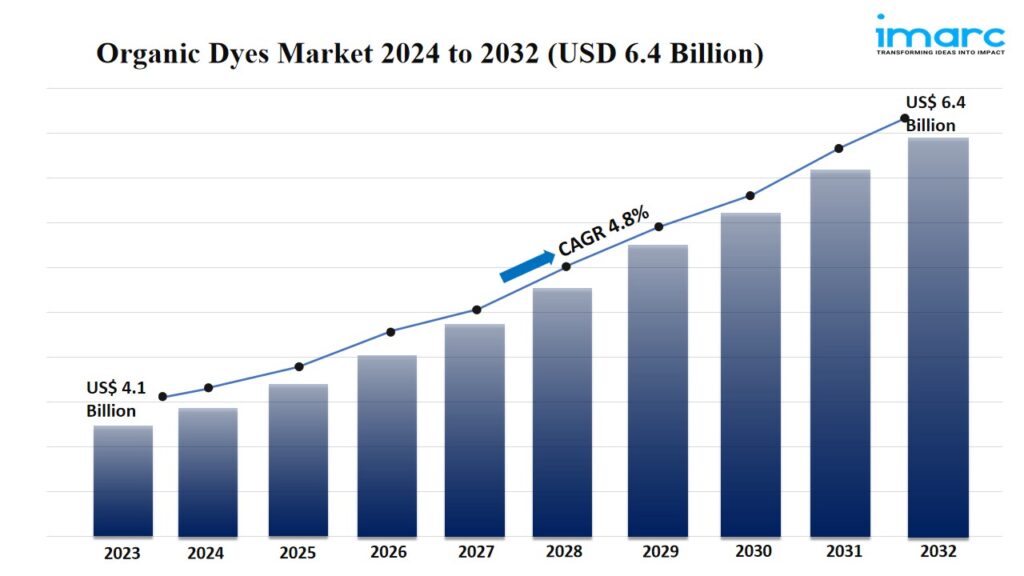IMARC Group’s report titled “Organic Dyes Market Report by Product (Acid, Basic, Reactive, Direct, Disperse, Sulphur, and Others), Source (Animal, Plant, Minerals), Application (Paints and Coatings, Textiles, Plastics, Printing Inks, and Others), and Region 2024-2032”. The global organic dyes market size reached US$ 4.1 Billion in 2023. Looking forward, IMARC Group expects the market to reach US$ 6.4 Billion by 2032, exhibiting a growth rate (CAGR) of 4.8% during 2024-2032.

For an in-depth analysis, you can refer sample copy of the report: https://www.imarcgroup.com/organic-dyes-market/requestsample
Factors Affecting the Growth of the Organic Dyes Industry:
- Increasing Environmental Awareness and Regulations:
Individuals are becoming more conscious about the environmental impact of their purchases, which is driving the demand for eco-friendly products, including organic dyes. These dyes are derived from natural sources and are perceived as safer alternatives to their synthetic counterparts, which are often criticized for their hazardous waste and potential toxicity. Governing bodies and environmental agencies in many countries are implementing stringent regulations on the use of chemicals in dyes, prompting manufacturers to adopt organic variants that have a minimal ecological footprint. This shift is not only in response to regulatory compliance but also aligns with the sustainability goals of numerous industries, such as textiles and cosmetics.
- Technological Advancements in Dye Production:
Advances in biotechnology and green chemistry are enabling manufacturers to produce organic dyes more efficiently and with greater color diversity and stability. Techniques like microbial fermentation and the extraction of pigments from agricultural waste are not only environmentally sustainable but also cost-effective, making organic dyes more competitive with synthetic alternatives. These technological improvements are enhancing the performance of organic dyes, making them more appealing for a wide range of applications, including textiles, printing, plastics, and cosmetics. The ability to produce vibrant, durable colors with lower environmental impact is attracting industries towards organic dyes.
- Demand in the Organic Food and Beverages:
Organic dyes are being used to enhance the appearance of food products without compromising their organic status. People are becoming more health-conscious and skeptical of synthetic additives, leading to a strong preference for natural colorants derived from sources, such as fruits, vegetables, and plants. This shift towards natural ingredients is supported by regulatory bodies that enforce strict guidelines on food coloration, further driving the demand for organic dyes. The appeal of organic dyes in food and beverages lies in their ability to meet consumer demands for purity, safety, and sustainability, encouraging manufacturers to incorporate these natural colorants into their product lines.
Leading Companies Operating in the Global Organic Dyes Industry:

- Albemarle Corporation
- Altana AG
- BASF SE
- Cabot Corporation
- DIC Corporation
- DuPont de Nemours Inc.
- Ferro Corporation
- Huntsman Corporation
- Kemira Oyj
- Kiri Industries Limited
- Lanxess AG
- Toyo Ink SC Holdings Co. Ltd
Organic Dyes Market Report Segmentation:
By Product:

- Acid
- Basic
- Reactive
- Direct
- Disperse
- Sulphur
- Others
Reactive exhibits a clear dominance in the market attributed to their strong covalent bond formation with fibers, providing superior wash and light fastness.
By Source:
- Animal
- Plant
- Minerals
Based on the source, the market has been classified into animal, plant, and minerals.
By Application:
- Paints and Coatings
- Textiles
- Plastics
- Printing Inks
- Others
Printing inks hold the biggest market share due to their widespread use in packaging, commercial, and publication printing.
Regional Insights:
- North America: (United States, Canada)
- Asia Pacific: (China, Japan, India, South Korea, Australia, Indonesia, Others)
- Europe: (Germany, France, United Kingdom, Italy, Spain, Russia, Others)
- Latin America: (Brazil, Mexico, Others)
- Middle East and Africa
Asia Pacific dominates the market owing to the rising demand from textile and garment manufacturing hubs in the region.
Global Organic Dyes Market Trends:
With the digital transformation, manufacturers and suppliers of organic dyes are leveraging online platforms to reach a wider audience, offering detailed product information, application guides, and virtual color-matching tools to assist buyers in making informed decisions. This digital approach not only enhances user engagement but also enables suppliers to tap into niche markets and cater to the specific needs of diverse industries, ranging from fashion and textiles to art and design.
Furthermore, the rise of social media marketing and influencer partnerships is playing a crucial role in raising awareness and promoting the use of organic dyes among individuals seeking sustainable and eco-friendly alternatives.
Note: If you need specific information that is not currently within the scope of the report, we will provide it to you as a part of the customization.
About Us:
IMARC Group is a leading market research company that offers management strategy and market research worldwide. We partner with clients in all sectors and regions to identify their highest-value opportunities, address their most critical challenges, and transform their businesses.
IMARCs information products include major market, scientific, economic and technological developments for business leaders in pharmaceutical, industrial, and high technology organizations. Market forecasts and industry analysis for biotechnology, advanced materials, pharmaceuticals, food and beverage, travel and tourism, nanotechnology and novel processing methods are at the top of the companys expertise.
Our offerings include comprehensive market intelligence in the form of research reports, production cost reports, feasibility studies, and consulting services. Our team, which includes experienced researchers and analysts from various industries, is dedicated to providing high-quality data and insights to our clientele, ranging from small and medium businesses to Fortune 1000 corporations.
Contact Us:
IMARC Group
134 N 4th St. Brooklyn, NY 11249, USA
Email: sales@imarcgroup.com
Tel No:(D) +91 120 433 0800
United States: +1-631-791-1145
